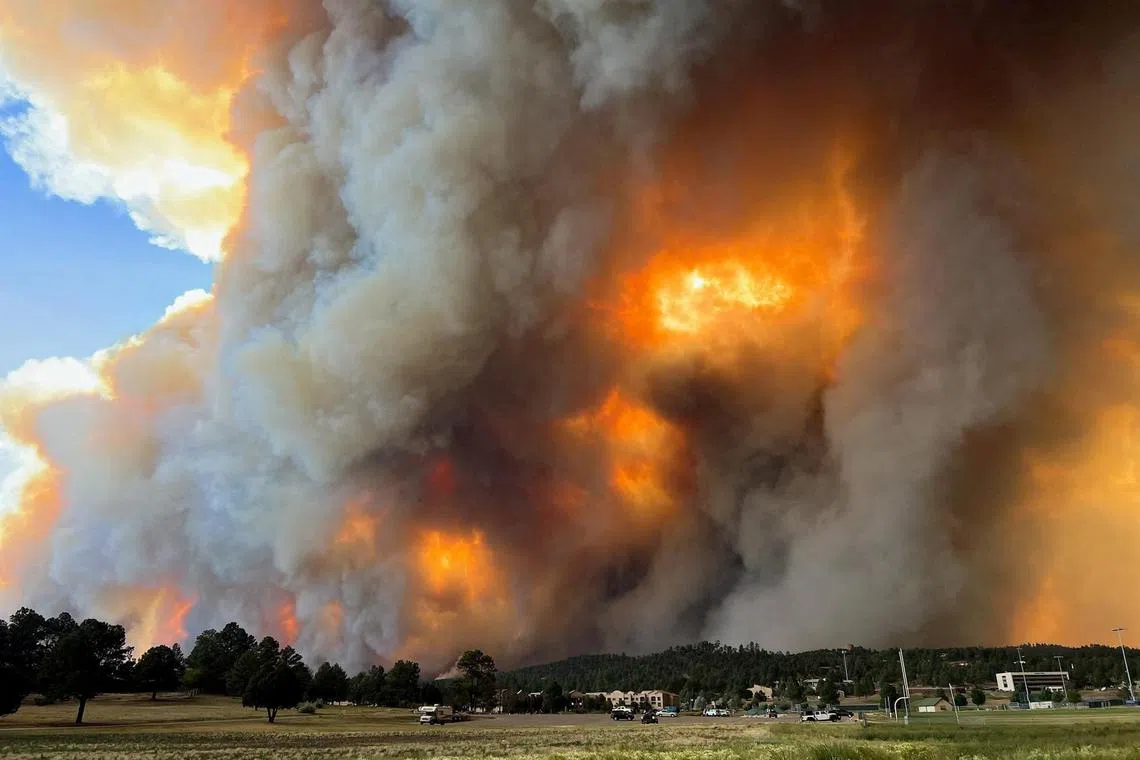Extreme wildfires have doubled in two decades: Study
Sign up now: Get ST's newsletters delivered to your inbox

Both the frequency and intensity of extreme wildfires have more than doubled in the past two decades, the study found.
PHOTO: REUTERS
Follow topic:
NEW YORK - The hottest year on record, 2023, was also the most extreme for wildfires, according to new research.
Both the frequency and intensity of extreme wildfires have more than doubled in the past two decades, the study found.
And when the ecological, social and economic consequences of wildfires were accounted for, six of the past seven years were the most “energetically intense”.
“That we’ve detected such a big increase over such a short period of time makes the findings even more shocking,” said Dr Calum Cunningham, a postdoctoral researcher in pyrogeography at the University of Tasmania and lead author of the study, published on June 24 in the journal Nature Ecology and Evolution. “We’re seeing the manifestations of a warming and drying climate before our very eyes in these extreme fires.”
Last week, wildfires in New Mexico killed two people
Even though wildfires can be deadly and cost the US up to US$893 billion (S$1.2 billion) annually, which includes the costs of rebuilding and the economic effects of pollution and injuries, most fires are “relatively benign and in most cases ecologically beneficial”, Dr Cunningham said.
The study looked at the total power emitted by clusters of fire events, defined as fires burning at the same time in proximity, or in the same spot, at multiple times in a single day.
The researchers analysed 21 years of data collected by two National Aeronautics and Space Administration satellites between January 2003 and November 2023 to quantify how fire activity has changed over time.
They identified 2,913 extreme events out of more than 30 million fires across the world. Such extreme fire events were also defined by the vast amount of smoke they emitted, their high levels of greenhouse gas emissions, which can further accelerate global warming, and the fire’s ecological, social and economic effects.
“This has been the holy grail for me,” said Professor David Bowman, senior author of the study and professor of pyrogeography and fire science at the University of Tasmania.
Although he observed fires growing stronger, especially in Australia after 2019’s bushfires killed 173 people and almost three billion vertebrates, he said he needed the data from the study to show a trend and convey something enormous is happening.
“When you have these signals that are so frightening, it’s also really motivating,” Prof Bowman said. “There’s an imperative to do something about this.”
The global increase in the frequency and intensity of fires was almost exclusively caused by changes in two regions.
In the temperate conifer forests of the western United States and Canada, extreme fire events increased to 67 in 2023.
The boreal forests of North America and Russia’s northern latitudes saw a more than sevenfold increase in energetically extreme fires.
The scientists plan to examine why the fires in these biomes were so extreme, but Dr Cunningham said their findings were consistent with the effects of climate change, which make conditions hotter and drier in these forests and more conducive to extreme events.
This scale of wildfire threatens not only nearby communities but people living far away because dense smoke can significantly affect air quality and can travel great distances.
“The largest smoke events come from the most intense fire events,” said Colorado State University professor of atmospheric science Jeffrey Pierce. “If you don’t have the ability to clean air in your home or seek places that have air purification systems”, wildfire smoke can have strong health effects.
Dr Jennifer R. Marlon, a research scientist and lecturer at the Yale School of the Environment and the Yale Programme on Climate Change Communication, said the study showed that humans are changing patterns of forest and grassland burning far beyond what humans have ever done.
“Larger and more severe wildfires are one of the most obvious manifestations of a planet that is heating up,” Dr Marlon said in an e-mail. “If we can help people better understand that connection, we may be able to build support for working more quickly to reduce the root causes of the problem – burning fossil fuels.” NYTIMES

